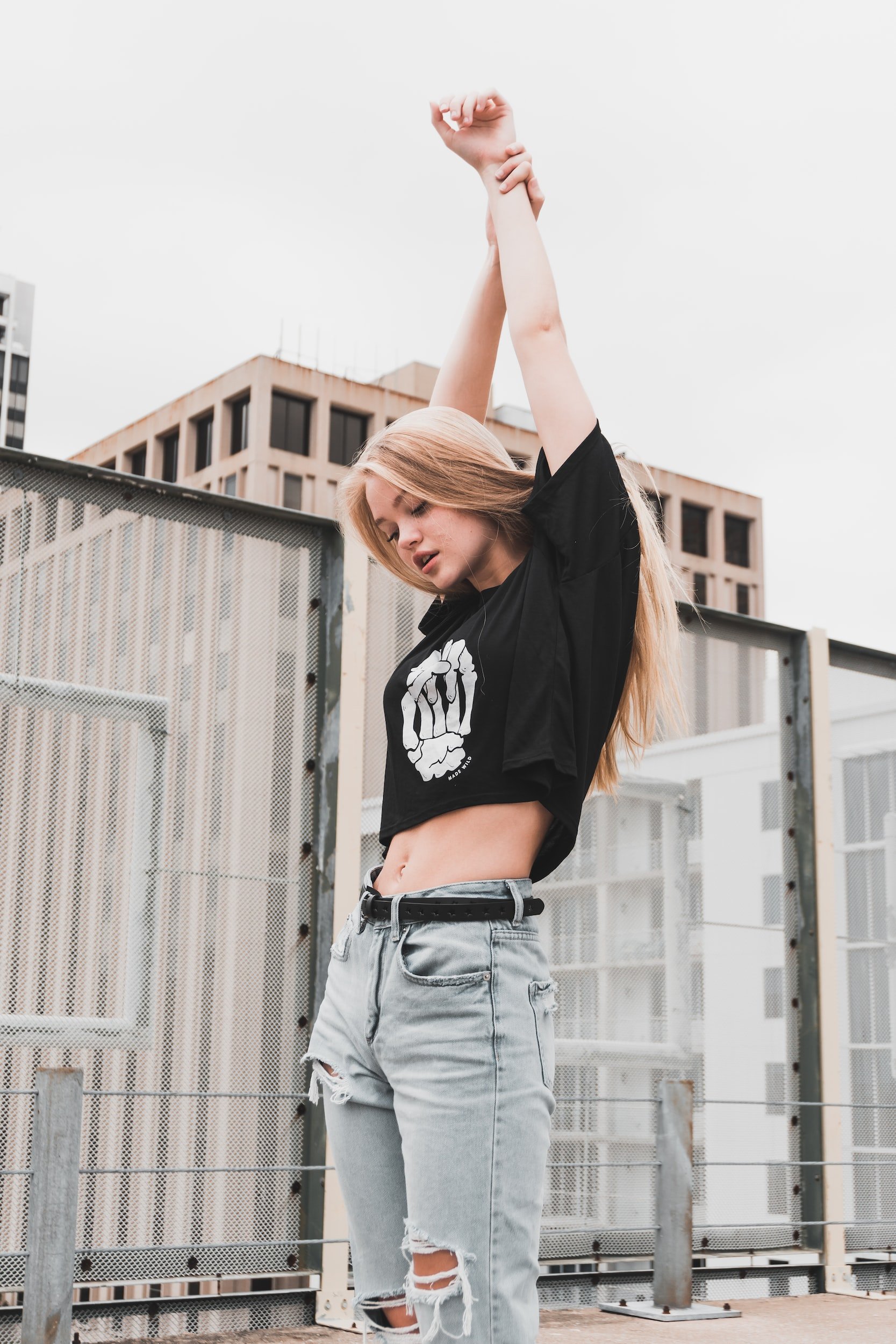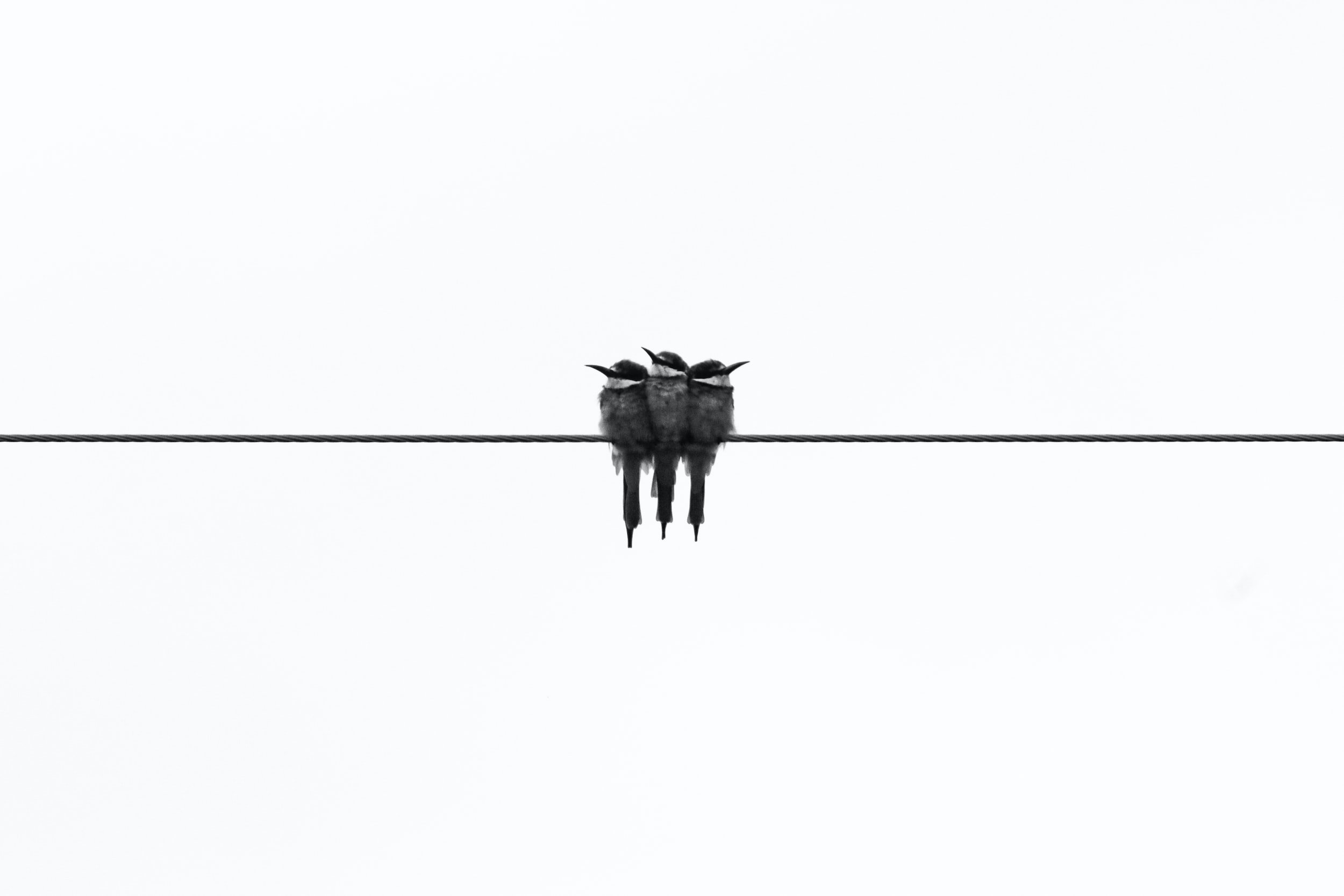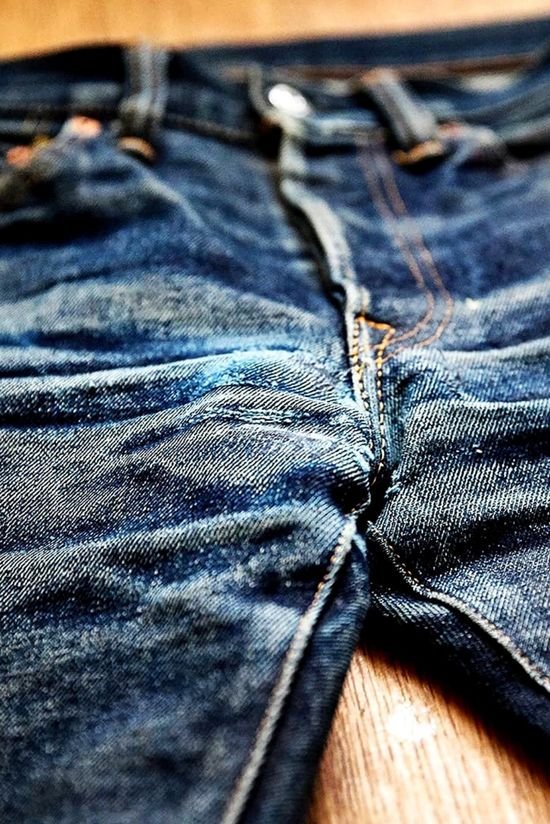DO YOUR JEANS HAVE A SOUL?
“At once esoteric – with a sacred status among denim heads – the humble jean remains one of the most deceptively complex and mysterious garments of all time; one that can create an emotional connection with the wearer.”
- Katya Foreman, BBC Culture














DO YOUR JEANS HAVE A SOUL?
“At once esoteric – with a sacred status among denim heads – the humble jean remains one of the most deceptively complex and mysterious garments of all time; one that can create an emotional connection with the wearer.” - Katya Foreman, BBC Culture _____________________
“It’s a very personal thing because of the uniqueness of the dyeing… as you start to wear in your jeans they kind of take on their own personality … “each wear pattern is unique to the individual. It’s something that you wear over time and that moulds to your body and takes on character,” says Kara Nicholas, of Cone Denim, historic US denim manufacturer.Cone’s White Oak mill in Greensboro, North Carolina, until it’s closure in 2017 boasted a collection of vintage American Draper X3 model shuttle looms from the 1940s.“There is a depth and dimension that happens with those looms,” says Kara, “when people started collecting vintage jeans, there was this idea of trying to emulate or replicate that authenticity [from the ‘70s].”____________________“It’s this idea that jeans have a soul, that they become a part of you, as the way they wear is unique to each person” says Enrique Silla, CEO of Jeanologia (market leader in sustainable technologies related to the manufacture and finishing of jeans)“When we go to the denim store, subconsciously we are looking for something similar to our favourite old pair of jeans.”soulfulness And sustainability
DAgoulT is a denim label made in the heart of the manufacturing district of Los Angeles. Inspiration is taken from nature, and the intelligence of the natural world. Fabrics and materials are sourced from heritage mills in Japan and Italy, and there is a focus is on stretch (women's). One aspect of the brand's approach to sustainability is linked to the special quality of the denim and its compact weave, hence longer envisaged life cycle- in comparison to normal high performance stretch denims that don't tend to enjoy the same sense of depth or soulfulness.The soulfulness of our denim
And so it follows, the question of what it is about our jeans exactly that gives us that sense of their having a soul?And then it also follows, the question of how, with reference to the wide variety of denims that we come across in the marketplace, can soulfulness relate to sustainability?Well, soulfulness is something to do with the way your jeans evolve - ripening and maturing with age and wear, moulding to the wearer’s gait, movement, lifestyle. Engaging in a dialogue with the wearer, the jeans are quietly doing what they can to assist, aid and abet the wearer in living their best life.It's in the very nature of denim that it looks better worn, aged, and ripened. Whatever happens, denim softens and improves with age, and the way it matures is then connected to the wearer. As it is the wearer who is exerting pressure on the denim to age, ripen and mature it. And then this idea gets turned around and spun into the myth of the jeans doing the work on behalf of, or at least in cahoots with, the wearer- that there is some kind of symbiosis going on, that the jeans genuinely have a ‘soul’, which is most likely an exaggeration. But the sense of soul is still there. And it’s in the nature of the fabric that it softens, creases, tears and fades, characterfully almost however badly (or well) it’s treated. Denim is a resilient but supple fabric that needs to be weathered or beaten up to start looking, and performing, its best.Then it's also true that some denims have a greater, or lesser, sense of having a soul than others. And so it's here that for us is the key to denim and sustainability: as this is then to do with how they're initially made, or manufactured. How the denim is spun- from raw, carded, cotton into denim yarn- and then dyed. And it’s in these two things, the spinning and the dyeing, that’s basically defined or shaped the true character of the denim. Durability is also key, as durability enables a truer realisation of its ageing potential, and ultimately soulfulness.Then there is also, in addition to the spinning and the dyeing, a third key characteristic being the length of the individual fibers: whether the cotton is short or long staple (long staple cotton being finer and stronger than short staple). So it’s somewhere around here there lies, for us at DAgoulT, the first part of the key to denim and sustainability.Denim that molds and ages more "soulfully" entices a deeper, emotional response from the wearer, and brings with it a different sense of ownership, and is likely to remain in circulation, for an extended life-cycle. And having intrinsic value as to its fabrication, is more likely to be re-purposed, up-cycled, and re-circulated or recycled. As has indeed been happening to vintage jeans from the ‘70s.But it also so happens that denim that's spun and dyed in the above mentioned 'soulful' way (dual-ring-spun, and rope-dyed) possesses both core integrity (resilience, tensile strength) and inherent character from its very outset. i.e. It is both harder wearing and also more supple and more characterful than standard denim, even in its untreated virgin form, and that's something that's down to its weave- that's just what you get with dual-ring-spun, rope-dyed denim. Also one of the reasons surely for denim’s meteoric rise from its humble origins as rugged workwear in the 1800s, a workwear-only textile, to one of the most coveted fashion fabrics of all time, and why the world so fell in love with denim from the 1800s right through to the end of the 1970s and in a way never seen since, as it was all simply dual-ring-spun and rope-dyed back then (unlike today), even for the more competitively priced, mass market offerings. Looking ahead, this combination of durability (of dual-ring-spun, rope-dyed denim) with a profusion of inherent character right from its untreated, virgin form, means that in addition to the things mentioned above about its soulfulness, connectivity with the wearer, there is the less of a need to age and wear it down with chemicals at its early, industrial laundry stage, allowing that process of ageing, and the worn-in look to evolve naturally, organically, through wear- just as was done back in the '70s (and prior), and as indeed this kind of denim is suited to.Or at the very least to make significant strides in reducing the need for chemicals at the initial wash house stage, still maintaining a sufficiently enviable looking product for the end user to buy into.It also so happens that in today's marketplace the raw material, cotton, for this kind of denim (dual-ring-spun, rope dyed) tends to be sourced from cotton that's longer staple, and farmed more sustainably, due to the premiums involved. No doubt this is also a direction to which the industry, even at mass market levels, could in principle transition to- with time (i.e. produce less, but better). And so you could say this is another part of the key for us to denim and sustainability- which is the need to artificially age and wear down 'soulful' denim less during the industrial laundry process (and therefore the less of a need for the use of harmful chemicals), as this process would be better left be done naturally, through natural wear. As indeed this kind of denim lives best.And conversely, if your jeans have a soul, or a true sense of having a soul, more than likely they’re made of dual-ring-spun, rope-dyed denim, and are therefore on this basis we would argue more sustainable.____________________
Girl in DAgoulT.
Dual-ring-spun, rope-dyed jeans-


Long Staple cotton
Long staple cotton, where the length of the individual fibers is between 1 1/2” - 2 1/2”, is softer, silkier, and more durable than short staple cotton.Long staple cotton is sought after but also more expensive to cultivate and in shorter supply.Long staple cotton is still included in the denim offerings of a handful of premium denim mills today in Japan, Italy and Turkey.The Spinning: Ring-Spinning (v. open end)
There are two industrial methods today of spinning raw (carded) cotton to make the thread that then gets dyed and woven into denim fabric.Ring-spinning is the traditional method (and our preference), which is also the way cotton yarn was spun from pre-historic times right through to the mid-1980s.Ring-spinning originally started off as a manual process using spindles, the individual cotton fibers roll-twisted into yarn on spindles rotated by hand, and was successively semi-automated via innovations such as the Spinning Wheel, to the Spinning Jenny, to the Throstle Frame, to Arkwright’s Water Frame (of 1765), and then fully automated via the Ring Frame of 1829, with successive upgrades to the Ring Frame continuing through the decades (and century) right up to the 1970s and beyond—- all of which were based on the same basic principle of spinning the thread by roll-twisting the fibres into yarn via rotating spindles.Rotary, or open-end, spinning was innovated and commercialised in the late 1970s to early 1980s, could deliver yarn 7-9 times faster than ring-spinning, and was also significantly cheaper. And by the mid-’80s was adopted industry-wide for spinning cotton yarn for mass-produced denim globally. In ring-spinning the fibres are rolled into shape by being wound around a rotating spindle, whereas in open end (rotary) spinning the fibres are air-twisted and effectively pressed into shape through a centrifugal action, by currents.Ring-spinning produces a stronger, more compact yarn, and - in addition to its higher durability and tensile strength - a softer and silkier hand.Ring spinning also introduces ‘slubs’- natural imperfections created through the process, that in denim give what is deemed character and beauty and- then also- a certain sought after ‘authentic, vintage denim’ look in terms of appearance, right from the outset.Rotary spun/ open-end denim tends to have a more open, fuzzier appearance and a coarser hand.And so, to be specific, it's in the spinning, in our view, the main key to creating beautiful and ageing worthy denim.And it also follows, with the industry-wide change in the spinning (to open-end) in the mid-1980s, from the mid-1980s onwards it was now a different kind of denim that was being produced and distributed into the global marketplace, with effectively a change in its core or you could say ‘molecular’ structure.The strongest, most beautiful denim is dual-ring-spun (“ring x ring”), where both the warp and weft yarns are ring-spun.Against a backdrop of mass produced denim today which is either open end (rotary spun); or ring-spun where just the weft yarn is ring-spun and the warp is open end.The consequence of this transition to open-end spinning in the ‘80s wasn’t quite understood or forseen by the consumer or even within the industry at the time, and still today it remains a big question mark to many (who still aren't aware there is close to a binary difference in the type of denim created by the two different spinning methods), although the frustrations for the consumer are, and the reverence for vintage is, very much ever present.Dual-ring-spun yarn, the sine qua non for bona-fide ‘soulful’ denim, is indeed produced today via a handful of Japanese mills, and a select few in Italy and Turkey. And generally only found within the higher bracket of premium denim. And again, is probably the key area which the industry should be looking towards, in the interests of sustainability in the long term, and prices would no doubt adjust to some degree with economies of scale, over time. Ring-Spinning: Richard Arkwright’s Water Frame, as first used in 1765. Patented in 1769Originally powered by waterwheels (and horses).Ring-Spinning: the Ring-Frame at Kurabo Mills, Japan. Circa 1915Ring-Spinning - modern Ring Frame for higher production, circa 1980Open End Spinning: Titan, TQF 368, a modern day open end spinning machineThe Dyeing: Rope dyeing vs. Today’s Slasher or Sheet dyeing
In 1915 Rope-dyeing was automated and established- a kind of next stage progression of hank or skein dyeing (the go-to method of dyeing denim since the 1500s).It was based on similar principles as traditional hank or skein dyeing, involving dipping bundles of yarn (now ropes) into successive dye baths, followed by skying (oxidation) after each dip.Only with the ropes you now got the bonus of a ‘ring-dye’ effect (varying degrees of penetration of the dye where the surface area of the ropes is more- or less- exposed).This ‘ring-dye’ effect that you get from rope-dyeing is now sought after today for its quirky, dynamic and a kind of multi-dimensional finished look it gives to the dyed yarn, and this is one of the factors which contributes to rope-dyed denim inducing that precious sense of your jeans having a ‘soul’.Rope-dyeing has however for the most part been since replaced (again post mid-’80s) by the 7-9 times faster and cheaper modern day ‘slasher’ or ‘sheet’ dyeing. Rope-dyeing introduces a greater sense of depth to the weave, as well as a deeper, richer hue and better fade characteristics, as compared to the modern day slasher or sheet dyeing method.The modern day “slasher” or “sheet” dyeing involves beaming the yarn onto large sheets, then dipping the sheets into successive dye baths.This process creates a more basic, uniform, even look to the dyed yarn- without the “ring dye'“ effect, or depth of hue and richness of caste that you achieve with the ropes. And crucially- the modern day slasher or sheet dyeing results in a less characterful fade propensity to the dyed fabric.So, other than in the spinning (ring-spinning), the 2nd, or you could say "ancillary" key to creating characterful, soulful denim is in the dyeing- rope-dyeing.And while rope-dyeing was the go-to method of dyeing denim throughout the industry, globally all the way from around 1915 to the mid 1980s, slasher or sheet dyeing is what virtually the whole industry switched to in the 1980s- and in parallel with ring-spinning rope-dyeing is today maintained by only a handful of premium denim mills in Japan, and one or two Italy and Turkey, generally also only available within certain higher echelons of premium denim.An industrial rope-dyeing plant, circa 1980A modern day indigo slasher (or sheet) dyeing plantAnd finally
It is also true on the other hand that around the same time, from the 1980s onwards select Japanese mills came forward and experimented with techniques based on the old school method (ring-spinning, rope-dyeing - which are in our view the real key - and then also shuttle-loom weaving, which is for some “denim heads” the final, fourth part of the true equation for expert characterful and soulful denim)- and they began to push the limits of what denim is, beyond that of the heritage.
Those select Japanese mills created in the ‘90s and through the 2000s, and still are to this very day creating, more slubby, softer, silkier, more exquisite, more beautiful, more hard-wearing and more soulful dual-ring spun and rope-dyed denim than ever before, albeit today at price points that tend to exclude all but a certain bracket of the premium denim heirarchy.Again, no doubt there is room for manoeuvre here on price, and availability, which needless to say could come down and up respectively with demand and economies of scale.Worth a more formal appraisal, leading to a more concerted (industry-wide) effort in that direction?As the technology, and the workmanship, even in today's marketplace, is there available and ready to be sourced, availed.__________
Consequently DAgoulT as a brand sources its denim from dual-ring-spun and rope-dyed offerings, and generally spun from longer staple cotton within the scope of the mills in Italy and Japan that the brand is working with, these mills in turn recognised as industry forerunners in sustainable milling, dyeing and sourcing.Likewise for the manufacturing of the actual jeans. This is includes the minimal use and also treatment of toxic chemicals at the industrial wash house stage, which can often be a source of the worst pollutants, all carefully controlled within a closed loop circle, re-circulating clean waste-water into the local ecosystem, and working with sewing, laundry and finishing contractors with their own published and ongoing commitments to sustainability, ethical working practices, and to the higher bar of today's environmental regulations as instated (and closely monitored) by the City of Los Angeles where the jeans are made. DAgoulT denim/ dual-ring-spun and rope-dyed
__________
© 2025













